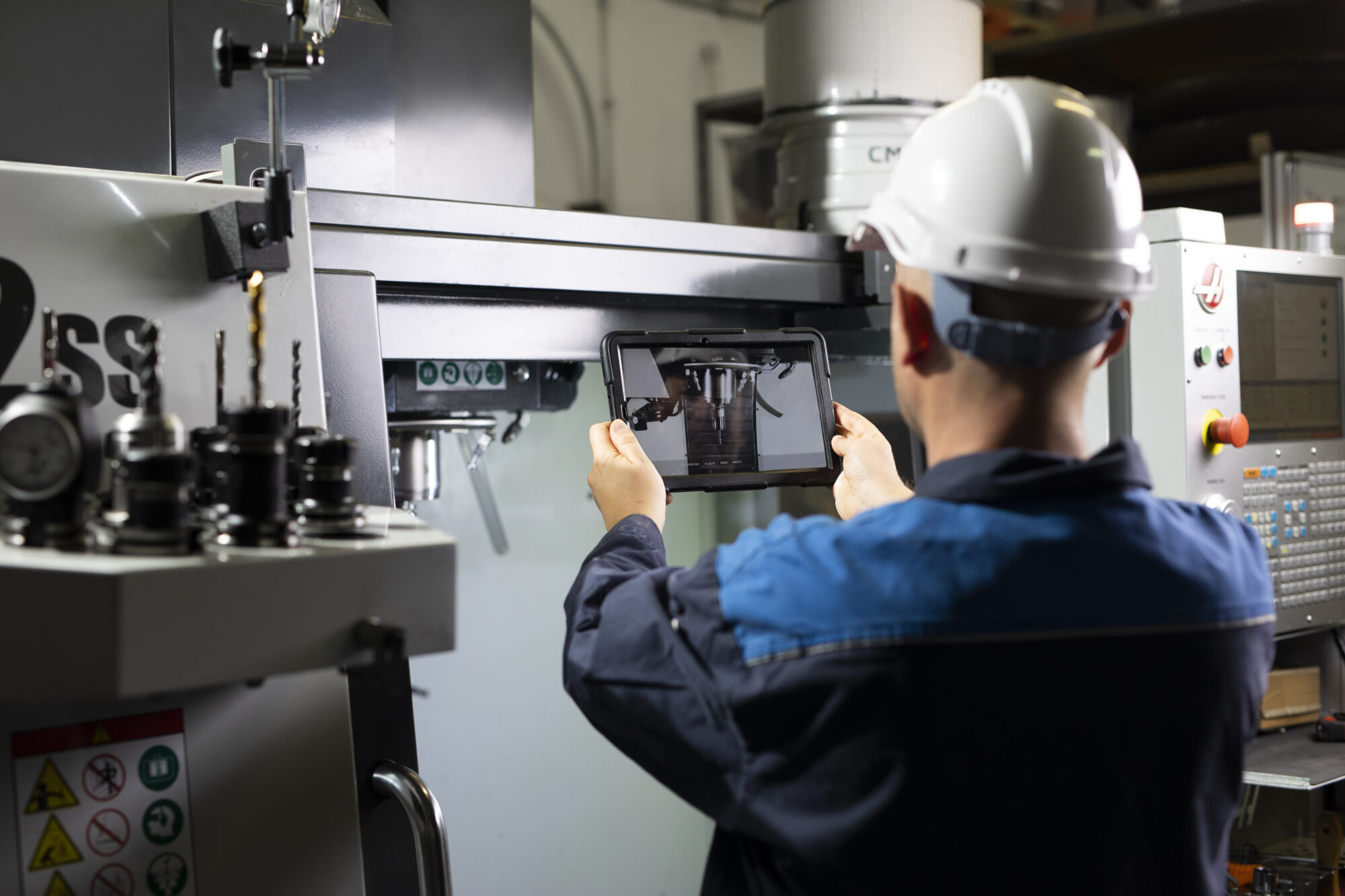Remote inspection plays a crucial role in industries including manufacturing, construction, and infrastructure, enabling professionals to assess and evaluate assets without physically being present at the site. Digital technology addresses the challenges and limitations of traditional remote inspection methods, proving that innovative solutions are required to transform the industrial landscape.
The power of augmented reality in remote inspection
Augmented reality (AR) technology emerges as a game-changer in the field of remote inspection, offering a wide array of benefits. AR enables the overlay of virtual information onto the real-world environment, enhancing visualization and data overlay capabilities. By wearing AR-enabled devices or utilizing AR applications on smartphones or tablets, inspectors can view relevant data, annotations, or instructions overlaid onto the physical objects being inspected. This augmented view provides inspectors with valuable insights, enabling them to detect potential issues, access documentation, and view historical data directly within their field of view.
Additionally, AR facilitates real-time guidance and support through features like remote expert assistance, where off-site experts can virtually guide inspectors, ensuring accurate assessments and reducing the risk of errors. The immersive and interactive nature of AR enhances the overall inspection process, improving efficiency and accuracy while reducing travel costs and downtime associated with on-site inspections.
The integration of AR in remote inspections
Remote inspection technologies have advanced significantly in recent years, and the integration of augmented reality has propelled these advancements further. Various innovative tools and platforms have emerged that seamlessly integrate AR into remote inspection workflows. For example, wearable AR devices, such as smart glasses, provide inspectors with a hands-free experience, allowing them to access information, data overlays, and expert guidance while keeping their focus on the inspection task at hand.
AR-powered mobile applications have also gained traction, enabling inspectors to leverage the capabilities of their smartphones or tablets to overlay digital information onto the real-world environment. These technologies enable inspectors to capture and annotate images, record videos, and access relevant documentation, all while maintaining a remote presence. The integration of AR into remote inspection technologies not only enhances data visualization and accessibility but also facilitates seamless collaboration and knowledge transfer between inspectors, remote experts, and other stakeholders involved in the inspection process.
AR remote inspection in practice
Real-world case studies showcase the successful implementation of AR remote inspection across various industries. In the manufacturing sector, AR-powered remote visual inspections tools have been utilized to perform quality control assessments on production lines. Inspectors wearing AR-enabled devices can view virtual overlays of specifications, measurements, and real-time analytics directly on the manufacturing equipment, facilitating efficient inspections and reducing errors. In the construction industry, AR remote inspection has been instrumental in assessing complex building structures. Inspectors can leverage AR to visualize architectural plans, identify potential design clashes, and overlay digital models onto the physical environment for precise measurements and alignment checks. These case studies demonstrate the practical benefits of AR in remote inspection, including improved accuracy, streamlined processes, and enhanced collaboration between on-site and off-site stakeholders.
Integration of AR into remote inspection workflows
The integration of augmented reality into remote inspection workflows enhances the capabilities and effectiveness of existing technologies. AR can be integrated into remote video inspection tools, enabling inspectors to overlay real-time annotations, data, or instructions onto the live video feed. AR can also be utilized with drones or robots equipped with cameras and sensors, providing inspectors with an augmented view of the remote environment and enabling them to perform inspections with enhanced visualization and guidance. The seamless integration of AR into these workflows improves the inspector’s situational awareness, data analysis, and decision-making capabilities.

presentation to try
Nsflow in action
Benefits of AR in remote inspection
Enhanced visualization and data overlay
AR empowers inspectors to visualize relevant information, such as equipment specifications, maintenance records, or sensor data, overlaid onto the physical objects being inspected. This provides inspectors with a comprehensive and contextual view of the assets, enabling them to identify anomalies, compare measurements, and detect potential issues more efficiently. The visualization of data overlays in real-time enhances the inspector’s understanding and enables them to make more informed judgments during the inspection process.
Real-time guidance and support
AR enables real-time guidance and support for remote inspectors, even when they are physically distant from the site. Through AR-enabled devices, inspectors can receive visual cues, instructions, or annotations overlaid onto their field of view. Remote experts can provide guidance, clarifications, or additional information, virtually guiding inspectors through complex tasks or challenging environments. This real-time support enhances the inspector’s confidence, reduces errors, and ensures that inspections are conducted accurately and efficiently.
Improved accuracy and efficiency
AR technology significantly improves the accuracy and efficiency of remote visual inspections. By providing inspectors with precise visual references, measurements, and alignment guides, AR minimizes human error and improves the accuracy of assessments. Inspectors can quickly identify deviations, validate measurements, and compare current conditions with historical data or design specifications. The real-time feedback and visual assistance offered by AR streamline the inspection process, reducing the time required for inspections while maintaining a high level of accuracy.
Enhanced collaboration and remote expert involvement
AR facilitates seamless collaboration between on-site inspectors and remote experts or stakeholders. By sharing the same augmented view, remote experts can remotely participate in inspections, review findings, and provide immediate feedback. AR enables inspectors to share their perspective, capture images or videos with annotations, and communicate in real-time with off-site colleagues. This enhanced collaboration allows for quicker decision-making, knowledge sharing, and expertise transfer, ultimately improving the overall quality and effectiveness of remote inspections.
Future trends in remote inspection
As augmented reality continues to evolve, future trends in AR remote inspection are emerging. Advancements in computer vision and AI algorithms are enhancing the capabilities of AR systems to automatically identify and annotate potential issues during inspections. Furthermore, the integration of remote sensing technologies, such as drones or robots equipped with AR capabilities, allows for remote inspection of challenging or hazardous environments. These trends hold the promise of further improving the efficiency and effectiveness of remote inspection processes. However, considerations such as data security, privacy, and standardization of AR interfaces and protocols need to be addressed to ensure seamless integration and widespread adoption of AR remote inspection technologies.
The takeaway
Augmented reality has the potential to revolutionize the field of remote inspection, empowering inspectors with enhanced visualization, real-time guidance, and seamless collaboration. By overlaying virtual information onto the real-world environment, AR remote inspection improves efficiency, accuracy, and accessibility, while reducing costs and travel requirements. As industries increasingly embrace the benefits of AR in remote inspection, it is vital for professionals to stay informed about the latest technologies, tools, and best practices to harness the full potential of AR and drive innovation in inspection processes.
With the continuous advancements in augmented reality technology, the future of remote inspection holds great promise for transforming the way inspections are conducted and revolutionizing industries globally.


























